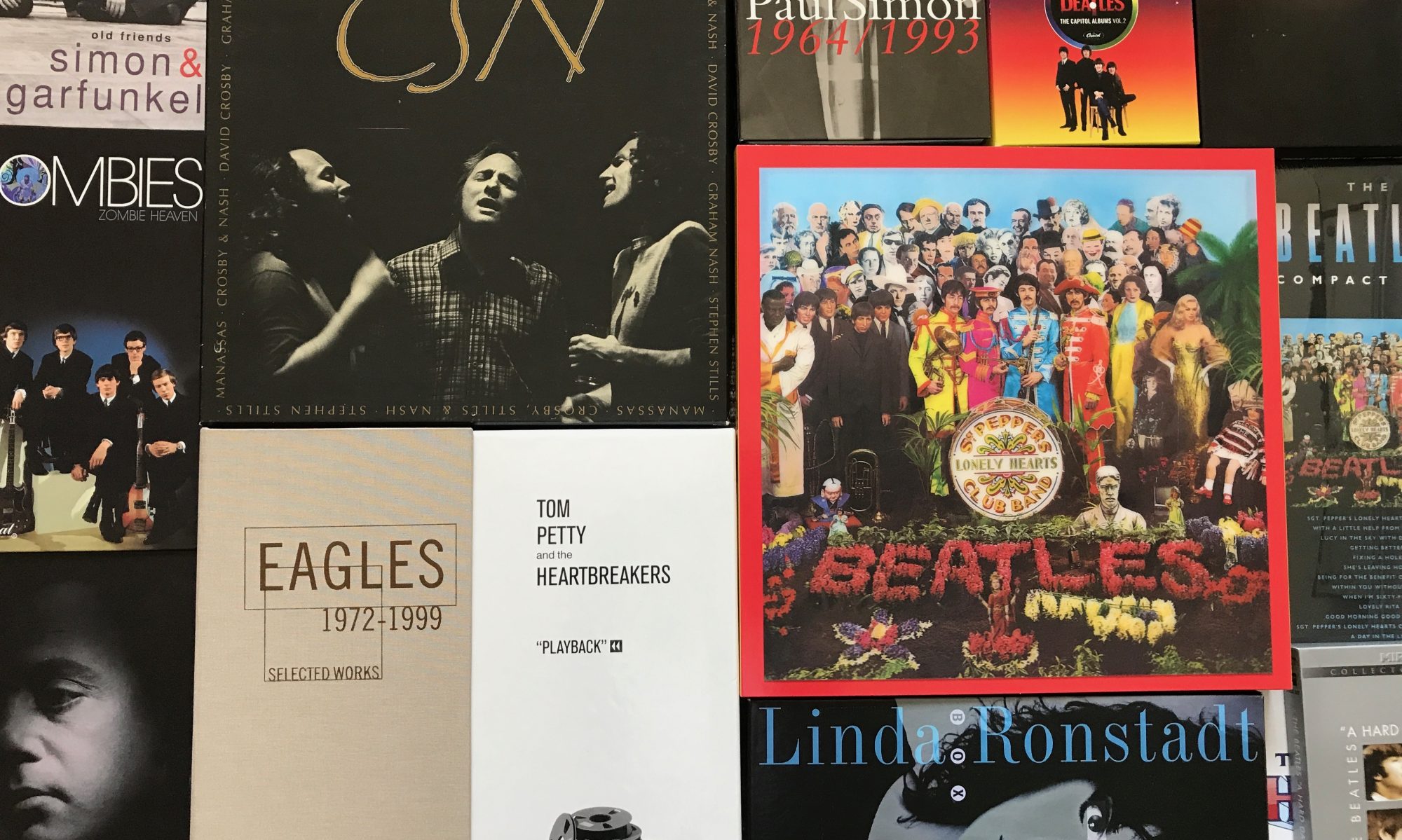It was 20 years ago today…that we visited the Rock & Roll Hall of Fame Museum in Cleveland, Ohio.
 (Four postcards we bought at the museum, click to enlarge)
(Four postcards we bought at the museum, click to enlarge)
It’s hard to believe it’s been that long. Back then, they didn’t allow photos to be taken inside the museum, so I made a journal of what we saw in order to help us remember.
The large main displays were “on loan” from artists or their families. In this case, we saw excellent displays from John Lennon and Neil Young…two of our favorite artists.
The Lennon display was particularly impressive. It had John’s Sgt. Pepper uniform, his collarless Beatles’ Jacket, and his black leather jacket from Hamburg, Germany.
 (John’s is the green jacket in this 50th anniversary Sgt. Pepper display)
(John’s is the green jacket in this 50th anniversary Sgt. Pepper display)
 There were four of John’s guitars, including the black Rickenbacker he used during the Shea Stadium concert, and the acoustic guitar he used for “Give Peace A Chance”. John’s hand-written lyrics for “In My Life” and “Lucy In The Sky With Diamonds” were on display, along with a gold record for Sgt. Pepper, and a pair of John’s famous wire-rim glasses. Plus, there were many more personal items, and promotional Beatles posters.
There were four of John’s guitars, including the black Rickenbacker he used during the Shea Stadium concert, and the acoustic guitar he used for “Give Peace A Chance”. John’s hand-written lyrics for “In My Life” and “Lucy In The Sky With Diamonds” were on display, along with a gold record for Sgt. Pepper, and a pair of John’s famous wire-rim glasses. Plus, there were many more personal items, and promotional Beatles posters.
 (Neil Young’s gigantic stage props from Rust Never Sleeps)
(Neil Young’s gigantic stage props from Rust Never Sleeps)
The museum had Neil Young’s oversized props from his Rust Never Sleeps tour. That included large Fender and Marshall amps and the huge microphone as shown above. There were Neil’s hand-written lyrics to “Rockin’ In The Free World”, and a leather jacket with fringe on it that he wore when he was in Buffalo Springfield.
 There was also a telegram from 4/28/82 complementing Neil on his Live Rust album, and saying “We’ve listened to it over and over and love it”…signed Paul & Linda McCartney. By the way, Neil Young inducted Paul McCartney into the Hall Of Fame.
There was also a telegram from 4/28/82 complementing Neil on his Live Rust album, and saying “We’ve listened to it over and over and love it”…signed Paul & Linda McCartney. By the way, Neil Young inducted Paul McCartney into the Hall Of Fame.
 (20-years ago we took these photos…actually, April 22nd, 1998.)
(20-years ago we took these photos…actually, April 22nd, 1998.)
There are permanent displays for artists who have been inducted into the Rock & Roll Hall Of Fame. We saw the new display for the Eagles (class of 1998). It included Glenn Frey’s first guitar, and Don Felder’s white double-neck guitar from “Hotel California”.
The Allman Brothers display had a Duane Allman Guitar, a Dicky Betts guitar, a Gregg Allman B-3 Organ, and a Butch Trucks drum set. There was also a bass case (possibly Berry Oakley’s) that was covered with stickers.
Other displays included:
Led Zeppelin guitars and costumes, including those worn by Robert Plant and Jimmy Page (black dragon outfit).
Paul Simon’s guitars from Simon & Garfunkel albums & Graceland.
Huge concert props used by Pink Floyd.
The Mamas & The Papas stage costumes.
Roy Orbison’s black guitar and horn-rimmed glasses.
Ricky Nelson’s guitar and hand-written “Garden Party” lyrics.
Elvis Presley’s costumes and old 78 rpm records.
A unique mic-stand that held 4 microphones for The Temptations.
The actual tape recorder used by Bob Dylan & The Band to record The Basement Tapes.
And those are just a sampling of what was there.
 (Our 1998 pamphlet for the Rock & Roll Hall Of Fame Museum)
(Our 1998 pamphlet for the Rock & Roll Hall Of Fame Museum)
Should you go see it? If you’re into music, I’d say…”A splendid time is guaranteed for all”. There’s something special about being right next to the actual guitars and items used by great musicians to create their art.
When we saw it, the newest inductees (Fleetwood Mac & Eagles) were from the 1970’s, because artists aren’t eligible until 25 years after they became successful. When we saw the museum, it was mostly for Rock artists, but now, a lot of Pop artists are included. At this time, the newest inductees would have to be from anytime before 1993.
No doubt the museum displays have undergone many changes over the past 20 years…and so has Rock & Roll.


















































































